This article is authored by Phoebe Kouvelas LL.M. and has been first published in the Art & Museum Magazine, Summer Issue, 2017, p. 24-25
Art sales have traditionally been facilitated through the use of third parties. The problem arises, however, where the existence, role and remuneration of multiple intermediaries in a transaction are not disclosed to the principal be it the seller, buyer or both. In fact, direct sales between a seller and a buyer are now the exception rather than the rule, and it has become the norm to expect as many as 10 intermediaries to be involved in a transaction of high-value art. Among other things, multiple intermediaries can trigger confusion as to who any given agent represents, in what capacity, with whose authorization, who is responsible for paying the agent and the amount of their fee. With confidentiality often cited as an excuse to avoid disclosure to the principals of the existence and role of any given intermediary, conflicts of interest inevitably arise with serious consequences for all involved.
THE STAKES ARE HIGH FOR COLLECTORS
The engagement of multiple undisclosed intermediaries can prove disadvantageous to collectors. For one, it can result in significant transaction costs when artworks are offered through successive dealers with commissions added by every intermediary. In such case, a buyer is likely to be defrauded when they pay for an artwork at an inflated price due to undisclosed commissions to any number of intermediaries.
From the point of view of the seller, the risk of being defrauded is also significant. It is quite often the case that the owner has not authorized their advisor to use third parties (sub-agents) in order to identify prospective buyers or even that the owner has not placed their artwork on the market for sale in the first place and is unaware of the fact that it is circulating by multiple agents for sale, all purporting to have a direct link to the owner. Such practices can have a detrimental effect on the value of an artwork; collectors are willing to spend significant amounts on art partly due to the fact that any given artwork is considered desirable and only a select few can own it. The value of a work of art that is circulating in the market and remains unsold (often because none of the intermediaries has access to the owner or simply because the owner has not mandated anyone to sell) can be considerably compromised and therefore savvy collectors must be very careful about how they offer a piece of their collection for sale.
Additionally, conflicts of interest arise where sellers agree to a net sale price with their advisors, allowing the latter to profit from any difference above the net amount. The risk here is that the advisor will be inclined to have the artwork undervalued in order to increase their own profit or in order to pay undisclosed commissions to various intermediaries unknown to the seller (or both). In the case of Accidia Foundation v Simon C Dickinson Ltd (2010), the seller experienced this the hard way when it received only US$ 5 million on a US $ 7 million sale of their art after several intermediary commissions were paid. The English High Court, however, opposed such practice; it ruled that the practice of net return price “would be objectionable as being unreasonable and unlawful unless it were concluded with the fully informed consent of the principal seller or the dealer accounted to that principal for the secret profit secured.”
INTERMEDIARIES RUN RISKS AS WELL
Intermediaries in art transactions whose existence is not disclosed and whose role is not transparent run legal and financial risks as well. For one, the bigger the chain of intermediaries who help locate prospective sellers or buyers, the more likely it becomes that any of them will be circumvented after they have made a key introduction which ultimately leads to a sale, resulting in potential financial losses due to unpaid commissions. In a similar manner, a sale that is facilitated by an unauthorized sub-agent, or the total commission earned by a string of agents exceeding the maximum commission allowed by the principal, can also lead to financial losses for the intermediaries involved.
But apart from lost earnings, intermediaries may face even harsher consequences where they operate with lack of transparency. Where they are deemed to owe a fiduciary (a legal obligation of one party to act in the best interest of another), acting in a way that breaches such duty can lead to loss and damage. Generally speaking, any action that does not put the principal’s best interests first is likely to breach the fiduciary duty owed by the intermediary. For example, putting oneself in a position of conflict of interest can lead an agent to knowingly undervalue an artwork in order to increase their own profit or to retain undisclosed commissions; such practices will almost always be considered a breach of fiduciary duty.
SECRET COMMISSIONS REVISITED: A RECENT DISPUTE
The complexity and severity of the issue of secret commissions has been highlighted by the multi-jurisdictional legal dispute between the Russian businessman Dimitry Rybolovlev and the Swiss art dealer Yves Bouvier. The case involves the sale of 38 paintings to Rybolovlev with every transaction engaging a chain of intermediaries not disclosed to the buyer and resulting in fraudulent price mark-ups of around $1bn due to unauthorized secret commissions, as Rybolovlev alleges.
The result and legal implications of this case remain to be seen when the various courts rule on the merits of the case. What is worth noting here is that the deciding point will be whether Bouvier was dealing as agent for Rybolovlev, in which case he owed a fiduciary duty to his client, or whether he was dealing at arm’s length, acting in his own interest, with a view to maximizing his own profit, in which case he will be deemed not to owe a fiduciary duty.
HOW CAN COLLECTORS BE PROTECTED?
To legally protect themselves from the negative consequences of undisclosed commissions, collectors can act pro-actively:
· Consignment Agreement. Where collectors consign a piece of art to a dealer for sale, a carefully drafted consignment agreement has become a necessary endeavor. Among other issues, such agreement should be clear about the dealer’s responsibilities and compensation and whether and how the dealer can compensate intermediaries in the course of the sale. A clause providing for a disclosure requirement or limit of related payments the advisor may collect is also wise to include.
· Net Price Sale. Where an owner enters into a consignment agreement with a dealer on a “net price arrangement”, the consignment agreement must place a cap on the total amount of commission retained above the net price. If there is no such cap, then the consignment agreement must include clear language that the owner is satisfied with the net price (specified in the agreement) and that the dealer is authorized to retain all monies above the net price, irrespective of the amount.
· Sale & Purchase Agreement. Where a seller and a buyer enter into a sale and purchase agreement directly with each other, terms in such agreement must include protective warranties and provisions relating to commissions.
HOW CAN INTERMEDIARIES BE PROTECTED?
Intermediaries can also act pro-actively to ensure their interests in an art transaction are safeguarded:
· Non-Circumvention Agreement. Where multiple intermediaries are involved in high-value art transactions, it is wise to enter into a non-circumvention agreement, especially where the intermediary has no direct link to any of the principals. Such agreement ensures that the intermediary will be compensated for any key introduction they make which leads to a successful sale and that they will not be circumvented after having rendered their services.
· Introductory Commission Agreement. It is wise for intermediaries to enter into an introductory commission agreement which will clearly state the manner and amount of compensation payable in order to avoid situations where the intermediary suffers financial losses due to unpaid commissions.
Clearly, lack of transparency in art transactions not only has ethical implications but also poses legal and financial risks for all involved. Both principals and intermediaries must be aware of those risks and seek advice on how to best safeguard their interests.





